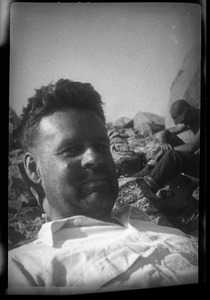Francis P. Farquhar
| Francis Peloubet Farquhar | |
|---|---|
 Farquhar, early 1930s | |
| Born |
December 31, 1887 Newton, Massachusetts |
| Died |
November 21, 1974 (aged 86) Berkeley, California |
| Occupation | Accountant |
| Known for | Mountaineering, environmentalism, California historian |
Francis Peloubet Farquhar (December 31, 1887 – November 21, 1974) was an American mountaineer and environmentalist. He graduated from Harvard and came to San Francisco to set up in practice as a Certified Public Accountant.
Early life
Farquhar was born in Newton, Massachusetts, the son of David Webber Farquhar (1844–1905) and Grace Thaxter Peloubet (1863–1943).[1] Graduating from Harvard in 1909, he came to San Francisco in 1910 and, after several business experiences, returned to New England to take up the profession of accounting, studying under Clinton Scovell, a pioneer in the field of cost accounting. In 1914 he came again to California, eventually setting up his own practice in San Francisco as a certified public accountant.[2]
California
Francis Farquhar was an active Sierra Club leader and served as its president 1933-1935 and 1948-1949. He served as Sierra Club Bulletin editor from 1926 to 1946, when that publication was one of the leading mountaineering journals in the world. He served in other club offices as a director from 1924 to 1951. Farquhar was a mountaineer who invited Robert L. M. Underhill to introduce proper use of modern Alpine rope techniques to Sierra Club members on an annual club High Trip in 1931. He made multiple first ascents. On August 26, 1921, he completed the first ascent of Middle Palisade by the south-west chute with Ansel Hall.[3]
Farquhar is the author of several books and wrote the foreword for other books. He is best known for his book History of the Sierra Nevada (1946), which is still in print. He had terms as president of the California Academy of Sciences, the California Society of Certified Public Accountants, and the California Historical Society.
In 1957 and 1958, Farquhar was editor of the American Alpine Journal published by the American Alpine Club.
Since 1970, the Sierra Club has given the Francis P. Farquhar Mountaineering Award in his honor.
Published works
- 1925: Exploration of the Sierra Nevada, California Historical Society
- 1926: Place names of the High Sierra, Issue 62 of Publications of the Sierra Club
- 1938: The Helmet of Mambrino, The Book Club of California
- 1948: Yosemite, the Big Trees and the High Sierra, Martino Publishing, ISBN 978-1-57898-155-7
- 1950: Flight to the North Pole, 24 August 1949, Grabhorn Press (Berkeley, CA)
- 1953: First ascents throughout the world, 1901-1950, Grabhorn Press (Berkeley, CA)
- 1953: The Books of the Colorado River & the Grand Canyon, Fretwater Press, ISBN 978-1-892327-14-7 *1957: Place names for Bohemians: Clubhouse to Grove, Silverado Squatters
- 1959: Naming Alaska's mountains: with some accounts of their first ascents, American Alpine Club
- 1965: History of the Sierra Nevada, University of California Press, Berkeley, ISBN 0-520-01551-7
- 1969: Joaquin Murieta, the brigand chief of California, Valley Publishers, (Fresno, CA)
- The topographical reports of Lieutenant George H. Derby
- Up and Down California in 1860-1864, University of California Press, Berkeley,
- Mountaineering in the Sierra Nevada
Family life
His wife Marjory Bridge Farquhar died 1999 in San Francisco. His half brother, the Los Angeles architect Robert D. Farquhar, retired and lived with him in Berkeley.
Legacy
Mount Farquhar (12,893'), located 1.6 miles (2.6 km) northwest of Mount Brewer in Kings Canyon National Park, was named in his honor.[4]
References
- ↑ David Webber Farquhar
- ↑ Biographical sketch (Bancroft Library)
- ↑ Roper, Steve, The Climber's Guide to the High Sierra (Sierra Club Books, San Francisco, 1976) ISBN 0-87156-147-6
- ↑ "Mount Farquhar". Geographic Names Information System, U.S. Geological Survey. Retrieved 2009-07-31.
External links
- Francis Farquhar Obituary (Sierra Club Bulletin)
- Francis P. Farquhar, Exploration of the Sierra Nevada (1925)
- Francis P. Farquhar, Place Names of the High Sierra (1926)
- Guide to the Francis P. Farquhar Papers at The Bancroft Library
- Portrait Photo on Mt. Whitney
- Francis P. Farquhar at Find a Grave
|